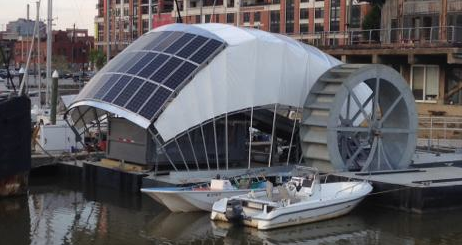
Click MENU Icon to Close

Click MENU Icon to Close
Natural Resources | Conservation & Restoration:
Force Blue: Weapons of Reef Construction: Transferring skills from military dive training, retired warriors are responding to a different kind of planetary threat: the loss critical ocean habitat. Force Blue is a non-profit organized by veterans to rebuild coral reefs. In their new mission, the group is not just helping to heal critical marine ecosystems; the program also therapeutically serves to support vets as they deal with issues related to military service and make the often difficult transition to civilian life. Continue Reading. |
|
Back to the Drawing Board on East Coast Offshore Drilling / Seismic Testing - Updated May & July 2017
After concerns were issued by both the Pentagon and NASA, along with much public outcry, in March 2016, the Obama administration put East Coast drilling plans on hold through 2022. During President Obama's last month in office, the Bureau of Ocean Energy Management issued denials for the pending applications for seismic exploration along the East Coast citing that there is no immediate need to conduct surveys since leases are off limits for the next five years. In April, President Trump issued the America First Offshore Energy Strategy. The Directive calls for the Department of Interior to review the drilling plan and now the agency is re-considering five applications for seismic surveys in the Atlantic that were denied under the Obama Administration. |
|
What You Need to Know About Sunscreen: Legislation has been introduced in Hawaii to ban Oxybenzone, a toxic chemical harmful to marine life, including marine mammals, corals, seagrasses and humans too! Non nano zinc sunscreens are the safest. Titanium Dioxide is also a good option. In addition to oxybenzone, you want to avoid butylparaben, 4MBC and octinoxate. For more information, check out the Environmental Working Group's Guide to Sunscreens. |
|
Virginia Governor Takes Climate Action Touted as a "Clean Energy Initiative," Governor Terry McAuliffe issued an executive order on Tuesday, May 16 to cut carbon dioxide emissions from power plants. Referring to climate change, the Governor notes that, "as the federal government abdicates its role on this important issue, it is critical for states to fill the void. ... Virginia will lead the way to cut carbon and lean in on the clean energy future." Executive Directive 11 calls for the promulgation of a regulation for the State Air Pollution Control Boards's consideration that will control carbon dioxide emissions from the main source, electric utilities, by December 31, 2017. Continue Reading. |
|
Avoiding a Collision Course - Local & Global Action During the 2015/16 winter, the Virginian-Pilot reported sightings of two humpback whales suffering injuries characteristic with ship strikes off of Cape Henry, and in the 2016/2017 season, at least 3 juvenile humpback whales stranded near the mouth of the Chesapeake Bay were apparent victims of ship collisions. To mitigate potential impacts that naval operations in and around the Chesapeake Bay region could have on migrating species, the Navy initiated a local 3 year study to establish a baseline of behavioral patterns for humpback whales in training and vessel transit areas. Whale ship strikes are unfortunately not just a local concern, they are an international problem. When you look at a map of the volume of ship traffic, its easy to see why. As an ecological dilema of global proportions, the United Nations is now considering how to protect whale species in their habitat that often overlaps with economically important trade routes. |
|
Large Offshore Protected Area for Deep-Sea Corals Codified Through a scrupulus process that involved multiple meetings and input from all stakeholders, a final rule designating The Frank R. Lautenberg Deep Sea Coral Protection Area was issued by NOAA in the Federal Register on December 14, 2016 and became effective on January 13, 2017. The affected areas lie about 100 miles off the coast stretching from Rhode Island to Virginia and includes known coral havens and those that are highly favorable coral locations, like deepwater canyons and slopes along the outer continental shelf. In total, the coral zone encompasses more than 38,000 square miles of federal waters off the Mid-Atlantic coast, an area approximately the size of the state of Virginia. |
|
VIMS Participates in International Harbour Initiative With major metro areas built around ports across the globe, coastal cities share common environmental, economic and social concerns. The World Harbour Project (WHP) was formed by the Sydney Institute of Marine Science to foster collaboration between scientists on common issues concerning the blue urban environment, including water quality and loss of biodiversity. Scientist Rochelle Seitz of the Virginia Institute of Marine Science (VIMS) has joined the WHP's global network of scientist investigating how to enhance the built marine environment and bring back native biodiversity lost to urbanization. Researchers representing more than a dozen institutions are involved in the Bivalve Restoration Project. Continue Reading |
|
Nonprofit and government agencies led by the Army Corps of Engineers have mobilized oyster restoration efforts. There’s just one problem. There is a shortage of natural shell to rebuild reefs. According to Jim Wesson of the Virginia Marine Resources Commission, “the price of shell has tripled over the last five years.” With high demand for shell for oyster aquaculture and limited supply available, the VMRC recommends the use of artificial substrate for sanctuary reefs which are not harvested. A new and unique reef material developed by an award winning Charlottesville architect and entrepreneur, looks to be a promising product to help fill the void. Read More - Image: Grow Oyster Reefs |
|
Resources & Apps for Enjoying Nature in and around Coastal Virginia There are many opportunities to get out an experience nature in the region. From pollinator gardening in your own backyard to venturing further afield, a whole host of free resources and apps are available to help residents and visitors enjoy the great outdoors in person or virtually. Highlighted in this feature are programs that share useful environmental info for touring, fishing, hiking, and paddling. Read More | Image: Fish Rules, Anglers App. |
|
National Microbead Ban Signed by the President! Read More. Fashion Sends an SOS for the Ocean - Apparel fabricated from plastic debris recovered from the sea is rolling into the marketplace. In a campaign championed by Virginia Beach native and pop icon Pharrell Williams, the artist is spotlighting the plight caused by pollution and an innovative solution. Through his contribution, he hopes to garner support and catalyze action. Read Post. |
|
The Climate Cure: Balancing Earth's Carbon Equilibrium by Transforming a Climate Liability into a Commodity World leaders agreed in Paris December 2015 to constrain global greenhouse emissions. During the landmark UN event, 195 countries committed to take steps that will slow the climate warming trend and limit the global thermostat from inching 2 degrees Celsius above historic averages. By engineering high tech as well as down to earth strategies, entrepreneurs aim to cash in on the carbon conundrum. A host of pioneering carbon offsetting initiatives are discussed including carbon trading, regenerative agriculture and biomass fixing, as well as drawing down ambient CO2 as a feedstock for products including fuel. Bay-Saver Bags similar to the Gulf-Saver Bags pictured here were planted along the Maryland shoreline as a carbon offset. Read more about developing carbon assets through biomass storage. |
|
 Clearwater Mills Trash Interceptor - Baltimore - During rain events, debris is carried into the Harbor where it accumulates. To remove the mass of floating garbage that arrives during every storm, a floating trash collection system has been deployed. Powered by the sun and river current, the barge system can remove 50,000 pounds of garbage a day. Read More. Clearwater Mills Trash Interceptor - Baltimore - During rain events, debris is carried into the Harbor where it accumulates. To remove the mass of floating garbage that arrives during every storm, a floating trash collection system has been deployed. Powered by the sun and river current, the barge system can remove 50,000 pounds of garbage a day. Read More. |
Check the Archive for Previous Posts
All Rights Reserved: Disclaimer